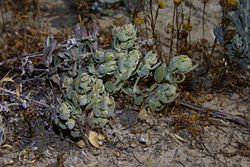Atriplex coronata
| Den här artikeln har skapats av Lsjbot, ett program (en robot) för automatisk redigering. (2014-07) Artikeln kan innehålla fakta- eller språkfel, eller ett märkligt urval av fakta, källor eller bilder. Mallen kan avlägsnas efter en kontroll av innehållet (vidare information) |
| Atriplex coronata | |
 | |
| Systematik | |
|---|---|
| Domän | Eukaryoter Eukaryota |
| Rike | Växter Plantae |
| Division | Kärlväxter Tracheophyta |
| Klass | Tvåhjärtbladiga blomväxter Magnoliopsida |
| Ordning | Nejlikordningen Caryophyllales |
| Familj | Amarantväxter Amaranthaceae |
| Släkte | Fetmållor Atriplex |
| Art | Atriplex coronata |
| Vetenskapligt namn | |
| § Atriplex coronata | |
| Auktor | S. Watson |
Atriplex coronata[1] är en amarantväxtart som beskrevs av Sereno Watson. Atriplex coronata ingår i släktet fetmållor, och familjen amarantväxter.[2][3] Inga underarter finns listade i Catalogue of Life.[2]
Källor
- ^ Watson, S., 1874A revision of the North Americean Chenopodiaceae.
- ^ [a b] Roskov Y., Kunze T., Orrell T., Abucay L., Paglinawan L., Culham A., Bailly N., Kirk P., Bourgoin T., Baillargeon G., Decock W., De Wever A., Didžiulis V. (ed) (2 september 2014). ”Species 2000 & ITIS Catalogue of Life: 2014 Annual Checklist.”. Species 2000: Reading, UK. http://www.catalogueoflife.org/annual-checklist/2014/details/species/id/16326470. Läst 26 maj 2014.
- ^ ITIS: The Integrated Taxonomic Information System. Orrell T. (custodian), 2011-04-26
Externa länkar
 Wikimedia Commons har media som rör Atriplex coronata.
Wikimedia Commons har media som rör Atriplex coronata. Wikispecies har information om Atriplex coronata.
Wikispecies har information om Atriplex coronata.
Media som används på denna webbplats
Robot icon
Atriplex coronata notatior (San Jacinto Valley crownscale) is a bushy, erect, federally endangered annual plant, 4 to 12 inches tall and endemic to western Riverside County, California. Plants occur in silty-clay soils in wetland areas, primarily floodplains, and are associated with alkali playa, and alkali grassland and scrub habitats. The small leaves appear grayish and scaly during the growing season, but become straw-colored as they mature. (Chris Brown/USGS)
